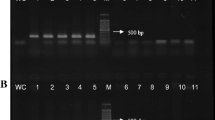Abstract
Genetically modified organisms have become a part of our everyday life. New modifications arise every year. The most of papers is focused on publication of detection protocols for genetically modified corn, soyabean, rape, or cotton. Minor modification, such as in potatoes attracts little attention. This work is based on developing an easy and cheap PCR method for the detection of an antimicrobial peptide from amaranthus which was used for transformation of potatoes. The base of the method is duplex PCR which enables identification of both potato and amaranthus specific genes in one tube. The method is enhanced by using positive plasmid controls which are able to reveal presence of inhibitors, reduce the incidence of false negative results, and wrong interpretation during analysis of routine samples.




Similar content being viewed by others
References
International Service for the Acquisition of Agri-biotech Applications – ISAAA (2004) Figures: Global Area (Million Hectares) of Biotech Crops, 1996–2004, by Country http://www.isaaa.org
Davies HV (1996) Potato Res 39:411–427
Slater A, Scott NV, Fowler MR (2003) Plant biotechnology, the genetic manipulation of plants. Oxford University Press Inc, New York
Liapkova NS, Loskotova NA, Maisurian AN, Mazin VV, Korableva NP, Platonova TA, Ladyzhenskaia EP, Evsiunina AS (2001) Prikl Biokhim Mikrobiol 37:349–354 (In Russian)
De Bolle MFC, David KMM, Rees SB, Vanderleyden J, Cammue BPA, Broekaert WF (1993) Plant Mol Biol 22:1187–1190
Broekaert WF, Marien W, Terras FR, De Bolle MFC, Proost P, Van Damme J, Dillen L, Claeys M, Rees SB, Vanderleyden J (1992) Biochemistry 31:4308–4314
Selitrennikoff CP (2001) Appl Environ Microbiol 67:2883–2894
De Bolle MFC, Osborn RW, Goderis IJ, Noe L, Acland D, Hart CA, Torrekens S, Van Leuven F, Broekaert WF (1996) Plant Mol Biol 31:993–1008
Ballagi-Pordany A, Belak S (1996) Mol Cell Probes 10:159–164
Acknowledgements
The work was partially supported by the grant No. MZE0002716201 from Ministry of Agriculture of the Czech Republic. Authors thank to Mgr. Maria Vass (Veterinary Research Institute) for critical reading of the manuscript, to Dr. Rozsypal (Research Institute of Crop Production, Prague, Czech Republic) for potatoes species mentioned in this work and to Dr. Zraly (Veterinary Research Institute, Brno, Czech Republic) for seeds of Amaranthus caudatus.
Author information
Authors and Affiliations
Corresponding author
Rights and permissions
About this article
Cite this article
Pribylova, R., Pavlik, I., Rozsypalova, Z. et al. A PCR-based method for the detection of genetically modified potatoes by the gene ac2 from Amaranthus caudatus . Eur Food Res Technol 223, 139–142 (2006). https://doi.org/10.1007/s00217-005-0171-2
Received:
Revised:
Accepted:
Published:
Issue Date:
DOI: https://doi.org/10.1007/s00217-005-0171-2




